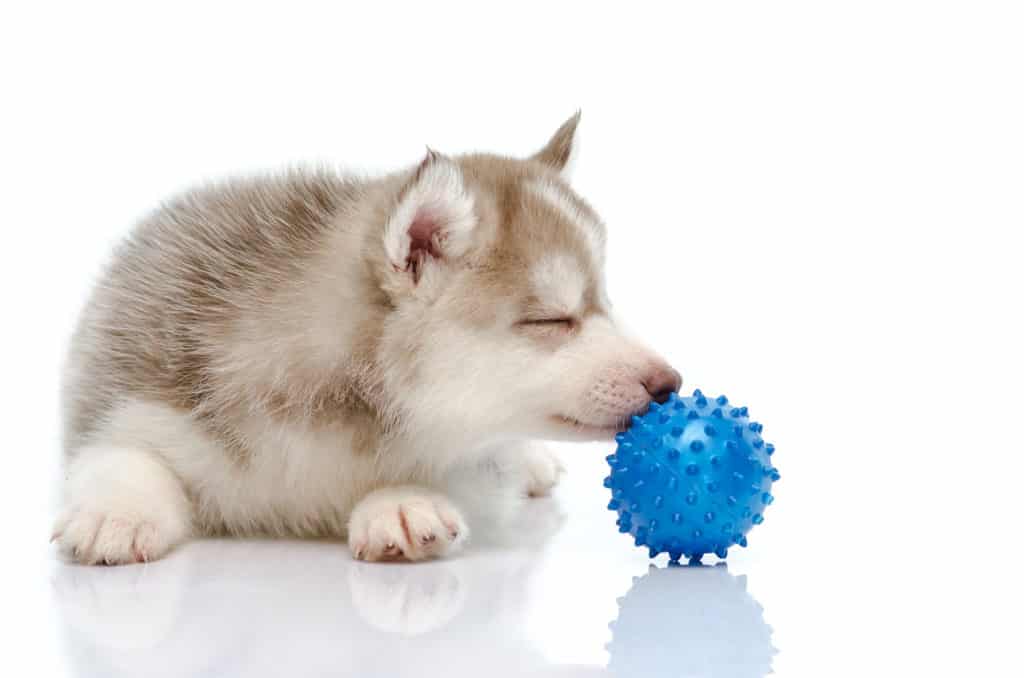Sable Huskies are beautiful Siberian Huskies with a lovely coat color that is often hard to describe.
With an almost “ombre” appearance to their fur that moves from black on the tops of their backs, to red, then down to white on the underbelly, this unusual coloring is as rare as it is stunning!
Here’s all you need to know about the sable Husky.
What Is A Sable Husky?
A sable Husky, also known as a sable-and-white Husky, is a type of Siberian husky with a unique coat coloring. This rare coloring is indicated by a reddish undercoat with black tipping on the ends of the fur.
The reddish color may be light orange, a copper or tan-like shade of red, or a full-depth, dark red tone that can appear close to a liver shade.
\The coat is never gray, though some sable Huskies are born with grey fur and develop a red tone later on as they mature.
What Coat Combinations Usually Breed Sable Huskies?
Husky genetics can be complex and complicated, as with any form of genetics. Recessive genes and unexpected ancestor traits can make it difficult to breed sable Huskies reliably without beginning with a pair of sable parents.
However, your best bets lie in Huskies with strong copper, red, or gray colorings, typically mixed with white.
How Rare Are Sable Huskies?
Sable Huskies are relatively rare, though not quite as rare as white or Agouti Huskies. There are no official statistics on the rarity of any Husky coat color, but suffice to say that sable Huskies are very rare in comparison to other coat combinations.
Are Sable Huskies Purebred?
Sable Huskies are typically purebred. Not that the sable coloring cannot exist in half-bred Huskies or mutts with strong Husky features.
However, there is nothing that indicates that sable Huskies cannot exist without mixing, and as such, they are purebred dogs.
Attributes Of The Sable Husky
1. Appearance
Sable Huskies’ primary difference in appearance from other Huskies lies in their coat coloring, as previously discussed, with red fur with black tips.
They are often called “black-nosed reds” because their noses are always black, instead of the tan, light tan, or liver shades seen in non-sable Huskies with copper or red colorings.
These noses may be square or pointed in appearance, though most show-quality dogs are expected to have a balance between the two shapes.
As a dog that, in its homelands, needed protection from harsh and frigid winters, Sable huskies have thick double coats.
Their undercoats are wavy and dense but quite fine, and their topcoats are straight and thick, with those black-tipped guard hairs. These coats can withstand extremely low temperatures, even up to -74 °F.
Sable Husky eyes are almond-shaped and can be many different shades. They may be blue, black, brown, or particolored. Meanwhile, their tails are sickle-shaped and covered with heavy fur and are often curled over the nose and face as a source of warmth.
Like all Huskies, sable Huskies are a medium breed. Males weigh between 45 and 60 pounds and are 20 to 24 inches tall. Females weigh between 35 and 50 pounds and may be between 19 and 23 inches tall.
These numbers are according to the breed standard, so some dogs may deviate from the norms.
2. Personality
Huskies are very gentle and friendly dogs. While they look intimidating, they’re very welcoming and love meeting new people. Incredibly loyal and very extroverted, these outgoing dogs can make friends just about anywhere and everywhere.
In addition, Huskies are even-tempered but mischievous dogs. It’s not unusual for them to be a little naughty for their own entertainment or to grab the attention of their owners.
Despite that, these dogs are fastidious and dignified, with an independent streak that means they’re capable of making their own decisions, even if they prefer to be surrounded by loved ones at all times.
Despite not being the most intelligent breed, sable Huskies are instinctively and adaptably intelligent, which is what has allowed them to be used for hauling freight across history. They’re capable of performing jobs independently without constant reassurance and commands from a handler or owner.
3. Temperament
Huskies of any kind are loud, vocal dogs that howl and bark extremely often and can be set off into a slew of noisiness at the slightest provocation.
However, they don’t make very good watchdogs, as they don’t have an aggressive or protective personality and treat everyone they meet as a friend.
In fact, sable Huskies are simply very open to strangers and can be very excitable upon meeting new and unfamiliar people. They’re also great family dogs and love living with children and other dogs.
Sable Huskies are also quite adaptable. They’ll adjust to new environments and can learn to be happy in most situations, as long as their basic needs and exercise needs are met.
As a curious and strong dog, this breed can get itself into quite a bit of mischief and trouble, often wiggling its way into and out of all sorts of situations.
Sable Huskies should have other dogs to live with, as they’re a very social breed and can become lonely and destructive when left to their own devices for too long.
Essentially, dogs of this breed are pack animals, through and through, and they feel an intense need to be a part of a pack.
4. Grooming Needs
Despite their thick fur, sable Huskies aren’t that difficult to groom. They’re even considered “natural”, a breed that can keep itself clean and requires only a few baths on an annual basis unless your dog is a show dog.
These dogs do shed quite a lot, but weekly brushings ensure that the coat is neat and the skin stays healthy.
There are two shedding seasons for Huskies, during which their undercoat is slowly shed away, and during this period you’ll need a metal comb and pin brush to rake away the old coat.
As with all dogs, a sable Husky’s nails should be kept nicely trimmed. This reduces the risk of foot and joint issues that can lead to long-term health issues.
5. Training
As with all dogs, sable Huskies require a good amount of early socialization to adapt well to other people. Basic obedience training and instilling polite manners is a must-do, which, again, is non-negotiable for all dogs.
Sable Huskies, like all Huskies, are neither very easy nor very difficult to train. Fun training activities and exercises will encourage a sable Husky to remain interested in learning and following commands, but commitment and regular work are necessary.

If you’re interested in training your sable Husky to use a harness or perform tasks or jobs, you can easily find tutorials, books, and videos on proper harness training for this breed.
Training for trail work is a well-practiced, well-understood process, and you’ll find plenty of resources available for this purpose. Expect to spend many hours and have a lot of patience to make this work.
6. Exercise Needs
Sable Huskies – and all Huskies – are highly athletic dogs. They like to be active and need a lot of daily exercise. With an extremely high level of energy. Huskies need space to run and need a very safely fenced-in yard to romp around in.
Do note that Huskies are notorious for being good escape artists, so safety is paramount, especially given how much the breed likes to run.
Huskies also need a lot of mental stimulation, often functioning best and at their happiest when they have some type of job to perform. Social interaction is also beneficial to their mental needs.
Forms of mental exercise can be puzzle toys, but things like agility, rally, and obedience course training can help to fulfill this breed.
7. Health
Huskies live up to between 12 and 14 years. Most purebred dogs have certain genetic health conditions to look for, but for the most part, Siberian Huskies are surprisingly healthy.
Most responsible breeders will screen for typical health problems, so as long as you get your sable Husky from a responsible establishment, your dog should be in good health for a long time.
In general, the two most important health tests for purebred sable Huskies are ophthalmologist check-ups and hip evaluations.
At the age of 12 months, a sable Husky that you plan to use for breeding should go through a full canine ophthalmologist check-up to reduce the risk of juvenile cataracts in future puppies.
In addition, if you have a working Husky, then you should seek a vet who is used to examining working dogs.
How Much Is A Sable Husky?
A normal purebred sable Husky from a reputable breeder may cost between $1,000 and $1,500, with a reasonable median price around $1,200.
However, this cost may not always include things like limited registration papers, which means the dog will not qualify for dog shows and other similar competitions. With that being said, most people seeking just a companion at home will not need those papers.
A sable Husky with all the right papers may cost between $1,500 and $3,000. If you want a purebred from a top-quality bloodline with champion or exceptional genetics, that can cost a small fortune, ranging from $1,700 to $10,000.
Most people aim to seek breeders willing to part with champion bloodline Huskies for a maximum of $2,500, but it’s up to you how far you’re willing to go!
Wooly Huskies, which are long-haired Huskies that technically do not meet the breed standard requirement for the medium-coated Siberian Husky, can be found in sable colorings, too. These dogs, while not eligible for show, are lower in price, between $1,000 and $2,000 for a good, healthy dog.
Finally, you can also opt to adopt a sable Husky if you find one available at a shelter or similar organization.
Rescue dogs often come with their own set of challenges in raising and caring for them, but they can be acquired for a lower adoption fee. That fee can range from $150 to $500, with an average of $350.
Don’t forget to factor in things like healthcare and food requirements for a sable Husky. It will likely cost at least $500 to feed one sable Husky with reasonably-priced, healthy food and treats for a year.
Meanwhile, vet expenses, including check-ups for common health problems, can total thousands of dollars.
Does The AKC Recognize The Sable Coat Coloring?
The AKC does officially recognize sable coat colorings as official, purebred Husky dogs, provided that they meet all other breed standard requirements. The sable-and-white coat is listed under Registration Number 165 for Huskies.
However, only saddle markings are considered the true breed standard for Huskies, so piebald patterns on sable colorings may not be accepted under the AKC’s standards.
Conclusion
Sable Huskies are unique and rare, but they’re still very much purebred Huskies, sharing the breed’s common temperament, personality, and needs.
While all dogs are different and some can be exceptions to common textbook descriptions, the primary difference between a sable Husky and the rest lies purely in the color of its coat.

